Experience Grammar: Creative Space Planning with Generative Graph and Shape for Early Design Stage
Abstract
:1. Introduction
2. Materials and Methods
2.1. Early Shape-to-Graph Computation
2.2. Graph by Shape Decomposition
2.3. Graph by Rule Schema
2.4. Shape and Graph Generative Rules
2.5. Revisit Synopsis
2.6. Shape-to-Graph Rules
2.7. Graph-to-Graph Rules
3. Case Study
3.1. Case 1: Hotel Lobby
3.1.1. Shape to Graph—Graph to Shape
3.1.2. Graph to Graph—Graph to Shape
3.2. Case 2: Trading Space
3.2.1. Graph to Graph
3.2.2. Graph to Shape—Shape to Shape
4. Results
4.1. Shape-Driven: New Spatial Experience for the Same Function
4.2. Graph-Driven: New Functional Experience with Similar Shapes
4.3. Graph- and Shape-Driven: New Functional and Spatial Experience
4.4. Rule Characteristics in Graph-to-Shape Iteration
5. Discussion
Funding
Data Availability Statement
Conflicts of Interest
References
- Boddy, N. Australia COVID: Office occupancy rates go backwards for the first time in six months. Financial Review, 11 August 2022. [Google Scholar]
- Zettl, M. Office buildings are still less than 50% occupied. Who should worry? Forbes, 29 November 2022. [Google Scholar]
- Duffy, F. Office buildings and organisational change. In Buildings and Society; Routledge: London, UK, 2003; pp. 147–163. [Google Scholar]
- WAF. World Architecture Festival 2022 Winners Homepage. Available online: https://www.worldarchitecturefestival.com/waf2023/en/page/waf-2022 (accessed on 5 December 2022).
- Amoils, J. The evolving workplace: Where to next in a post-pandemic world? CRE Real Estate Issues 2021, 45, 1–10. [Google Scholar]
- Duchene, P. The evolving workplace. Forbes, 12 March 2019. [Google Scholar]
- Sweeney, S. Post-Pandemic Utilization of Office to Residential Adaptive Reuse Strategies in Cities. Master’s Thesis, University of North Carolina, Chapel Hill, NC, USA, 6 April 2021. [Google Scholar] [CrossRef]
- RIBA. RIBA Plan of Work 2020 Overview; RIBA Publications: London, UK, 2020. [Google Scholar]
- American Institute of Architects, The Architect’s Handbook of Professional Practice; John Wiley & Sons, Incorporated: New York, NY, USA, 2013.
- Hillier, B.; Leaman, A.; Stansall, P.; Bedford, M. Space syntax. Environ. Plan. B Plan. Des. 1976, 3, 147–185. [Google Scholar] [CrossRef]
- Kim, Y.O.; Kim, J.Y.; Yum, H.Y.; Lee, J.K. A study on mega-shelter layout planning based on user behavior. Buildings 2022, 12, 1630. [Google Scholar] [CrossRef]
- Zhang, X.; Cui, T. Evolution process of scientific space: Spatial analysis of three groups of laboratories in history (16th–20th century). Buildings 2022, 12, 1909. [Google Scholar] [CrossRef]
- Lee, J.H.; Kim, Y.S. Rethinking art museum spaces and investigating how auxiliary paths work differently. Buildings 2022, 12, 248. [Google Scholar] [CrossRef]
- Azizi, V.; Usman, M.; Sohn, S.S.; Schwartz, M.; Moon, S.; Faloutsos, P.; Kapadia, M. The role of latent representations for design space exploration of floorplans. Simulation 2022, 375497221115734. [Google Scholar] [CrossRef]
- Stiny, G.; Gips, J. Shape grammars and the generative specification of painting and sculpture. In Proceedings of the IFIP Congress 71, Ljubljana, Yugoslavia, 23–28 August 1971; pp. 125–135. [Google Scholar]
- Belčič, A.; Eloy, S. Architecture for community-based ageing—A shape grammar for transforming typical single-family houses into older people’s cohousing in Slovenia. Buildings 2023, 13, 453. [Google Scholar] [CrossRef]
- Flemming, U. More than the sum of parts: The grammar of Queen Anne houses. Environ. Plan. B Plan. Des. 1987, 14, 323–350. [Google Scholar] [CrossRef]
- Cagdas, G. A shape grammar: The language of traditional Turkish houses. Environ. Plan. B Plan. Des. 1996, 23, 443–464. [Google Scholar] [CrossRef]
- Colakoglu, B. Design by grammar: An interpretation and generation of vernacular Hayat houses in contemporary context. Environ. Plan. B Plan. Des. 2005, 32, 141–149. [Google Scholar] [CrossRef]
- Yousefniapasha, M.; Teeling, C.; Rollo, J.; Bunt, D. Shape grammar, culture, and generation of vernacular houses (a practice on the villages adjacent to rice fields of Mazandaran, in the north of Iran). Environ. Plan. B Urban Anal. City Sci. 2021, 48, 94–114. [Google Scholar] [CrossRef]
- Erem, Ö.; Ermiyagil, M.S.A. Adapted design generation for Turkish vernacular housing grammar. Environ. Plan. B Plan. Des. 2016, 43, 893–919. [Google Scholar] [CrossRef]
- Haakonsen, S.; Rønnquist, A.; Labonnote, N. Fifty years of shape grammars: A systematic mapping of its application in engineering and architecture. Int. J. Arch. Comput. 2022, 14780771221089882. [Google Scholar] [CrossRef]
- Ehrig, H.; Pfender, M.; Schneider, H.J. Graph-grammars: An algebraic approach. In 14th Annual Symposium on Switching and Automata Theory (swat 1973); IEEE: Piscataway, NJ, USA, 1973; pp. 167–180. [Google Scholar]
- Rozenberg, G. Handbook of Graph Grammars and Computing by Graph Transformation; World Scientific: Singapore, 1997; Volume 1. [Google Scholar]
- Voss, C.; Petzold, F.; Rudolph, S. Graph transformation in engineering design: An overview of the last decade. Artif. Intell. Eng. Des. Anal. Manuf. 2023, 37, e5. [Google Scholar] [CrossRef]
- Weber, R.E.; Mueller, C.; Reinhart, C. Automated floorplan generation in architectural design: A review of methods and applications. Autom. Constr. 2022, 140, 104385. [Google Scholar] [CrossRef]
- Nourian, P.; Azadi, S.; Oval, R. Generative design in architecture: From mathematical optimization to grammatical customization. In Computational Design and Digital Manufacturing; Springer: Berlin/Heidelberg, Germany, 2023; pp. 1–43. [Google Scholar] [CrossRef]
- Heitor, T.V.; Duarte, J.P.; Pinto, R.M. Combing grammars and space syntax: Formulating, generating and evaluating designs. Int. J. Arch. Comput. 2004, 2, 491–515. [Google Scholar] [CrossRef]
- Eloy, S.; Guerreiro, R. Transforming housing typologies. Space syntax evaluation and shape grammar generation. Arq. Urb. 2016, 15, 86–114. [Google Scholar]
- Lee, J.H.; Ostwald, M.J.; Gu, N. A Justified Plan Graph (JPG) grammar approach to identifying spatial design patterns in an architectural style. Environ. Plan. B Urban Anal. City Sci. 2016, 45, 67–89. [Google Scholar] [CrossRef] [Green Version]
- Lee, J.H.; Ostwald, M.J.; Gu, N. A Combined plan graph and massing grammar approach to frank lloyd wright’s prairie architecture. Nexus Netw. J. 2017, 19, 279–299. [Google Scholar] [CrossRef] [Green Version]
- Lee, J.H.; Ostwald, M.; Gu, N. A syntactical and grammatical approach to architectural configuration, analysis and generation. Arch. Sci. Rev. 2015, 58, 189–204. [Google Scholar] [CrossRef]
- Etintaş, M.F.; Erem, N.Ö. Outpatient clinic design through rule based design methods. Eskişeh Tech. Univ. J. Sci. Technol.-Appl. Sci. Eng. 2022, 23, 156–171. [Google Scholar]
- Grasl, T.; Economou, A. From topologies to shapes: Parametric shape grammars implemented by graphs. Environ. Plan. B: Plan. Des. 2013, 40, 905–922. [Google Scholar] [CrossRef] [Green Version]
- Lima, F.; Brown, N.C.; Duarte, J.P. Optimizing urban grid layouts using proximity metrics. In Artificial Intelligence in Urban Planning and Design; Elsevier: Amsterdam, The Netherlands, 2022; pp. 181–200. [Google Scholar]
- Hong, T.-C.K.; Economou, A. Implementation of shape embedding in 2D CAD systems. Autom. Constr. 2023, 146, 104640. [Google Scholar] [CrossRef]
- Schaffranek, R.; Vasku, M. Space syntax for generative design: On the application of a new tool. In Proceedings of the Ninth International Space Syntax Symposium, Seoul, Republic of Korea, 31 October–3 November 2013. [Google Scholar]
- Stouffs, R. A Multi-formalism Shape Grammar Interpreter. In Computer-Aided Architectural Design. Design Imperatives Future Now; Gerber, D., Pantazis, E., Bogosian, B., Nahmad, A., Miltiadis, C., Eds.; Springer: Singapore, 2022; Volume 1465, pp. 268–287. [Google Scholar] [CrossRef]
- Lambe, N.R.; Dongre, A.R. A shape grammar approach to contextual design: A case study of the Pol houses of Ahmedabad, India. Environ. Plan. B Urban Anal. City Sci. 2019, 46, 845–861. [Google Scholar] [CrossRef]
- Veloso, P.; Celani, G.; Scheeren, R. From the generation of layouts to the production of construction documents: An application in the customization of apartment plans. Autom. Constr. 2018, 96, 224–235. [Google Scholar] [CrossRef]
- Vardouli, T. Skeletons, Shapes, and the Shift from Surface to Structure in Architectural Geometry. Nexus Netw. J. 2020, 22, 487–505. [Google Scholar] [CrossRef]
- Stiny, G. Shape: Talking about Seeing and Doing; The MIT Press: Cambridge, MA, USA, 2006. [Google Scholar]
- Stiny, G. Shapes of Imagination: Calculating in Coleridge’s Magical Realm; MIT Press: Cambridge, MA, USA, 2022. [Google Scholar]
- Hillier, B. The nature of the artificial: The contingent and the necessary in spatial form in architecture. Geoforum 1985, 16, 163–178. [Google Scholar] [CrossRef] [Green Version]
- Hillier, B. Space Is the Machine: A Configurational Theory of Architecture; Cambridge University Press: Cambridge, MA, USA, 1996; p. 463. [Google Scholar]
- Coates, P. Programming Architecture, 1st ed.; Routledge: London, UK, 2010. [Google Scholar]
- Alexander, C. Notes on the Synthesis of Form; Harvard University Press: Cambridge, MA, USA, 1964; Volume 5. [Google Scholar]
- March, L.; Steadman, P. The Geometry of Environment. An Introduction to Spatial Organization in Design; MIT Press: Cambridge, MA, USA, 1974. [Google Scholar]
- Muslimin, R. Ethnocomputation: An Inductive Shape Grammar on Toraja Glpyh. In Computer-Aided Architectural Design. Future Trajectories; Çağdaş, G., Özkar, M., Gül, L.F., Gürer, E., Eds.; Springer: Singapore, 2017; Volume 724, pp. 329–347. [Google Scholar] [CrossRef]
- Stiny, G. What rule(s) should I use? Nexus Netw. J. 2011, 13, 15–47. [Google Scholar] [CrossRef] [Green Version]
- Kotsopoulos, S.D. Design without rigid rules. In Design Computing and Cognition’20; Springer: Berlin/Heidelberg, Germany, 2022; pp. 107–128. [Google Scholar]
- Lee, J.H.; Ostwald, M.J.; Gu, N. Combining space syntax and shape grammar to investigate architectural style. In Proceedings of the Ninth International Space Syntax Symposium, Seoul, Republic of Korea, 31 October–3 November 2013; Sejong University: Seoul, Republic of Korea, 2013. [Google Scholar]
- Bowie, D. Innovation and 19th century hotel industry evolution. Tour. Manag. 2018, 64, 314–323. [Google Scholar] [CrossRef]
- Li, L.; Lu, L.; Xu, Y.; Sun, X. The spatiotemporal evolution and influencing factors of hotel industry in the metropolitan area: An empirical study based on China. PLoS ONE 2020, 15, e0231438. [Google Scholar] [CrossRef]
- Murphy, J.; Schegg, R.; Olaru, D. Investigating the evolution of hotel internet adoption. Inf. Technol. Tour. 2006, 8, 161–177. [Google Scholar] [CrossRef] [Green Version]
- James, K.J.; Sandoval-Strausz, A.K.; Maudlin, D.; Peleggi, M.; Humair, C.; Berger, M.W. The hotel in history: Evolving per-spectives. J. Tour Hist. 2017, 9, 92–111. [Google Scholar] [CrossRef]
- MacDonald, R. Urban hotel: Evolution of a hybrid typology. Built Environ. 1978, 2000, 142–151. [Google Scholar]
- Gauri, D.K.; Jindal, R.P.; Ratchford, B.; Fox, E.; Bhatnagar, A.; Pandey, A.; Navallo, J.R.; Fogarty, J.; Carr, S.; Howerton, E. Evolution of retail formats: Past, present, and future. J. Retail. 2021, 97, 42–61. [Google Scholar] [CrossRef]
- Miotto, A.P.; Parente, J.G. Retail evolution model in emerging markets: Apparel store formats in Brazil. Int. J. Retail. Distrib. Manag. 2015, 43, 242–260. [Google Scholar] [CrossRef]
- Quartier, K. Retail design: What’s in the name? In Retail Design; Routledge: London, UK, 2016; pp. 39–56. [Google Scholar]
- Bonfrer, A.; Chintagunta, P.; Dhar, S. Retail store formats, competition and shopper behavior: A Systematic review. J. Retail. 2022, 98, 71–91. [Google Scholar] [CrossRef]
- Stobart, J. A history of shopping: The missing link between retail and consumer revolutions. J. Hist. Res. Mark. 2010, 2, 342–349. [Google Scholar] [CrossRef] [Green Version]
- Stieninger, M.; Gasperlmair, J.; Plasch, M.; Kellermayr-Scheucher, M. Identification of innovative technologies for store-based retailing—An evaluation of the status quo and of future retail practices. Procedia Comput. Sci. 2021, 181, 84–92. [Google Scholar] [CrossRef]
- Hilken, T.; Chylinski, M.; Keeling, D.I.; Heller, J.; Ruyter, K.; Mahr, D. How to strategically choose or combine augmented and virtual reality for improved online experiential retailing. Psychol. Mark. 2021, 39, 495–507. [Google Scholar] [CrossRef]
- Treleaven, P.; Galas, M.; Lalchand, V. Algorithmic trading review. Commun. ACM 2013, 56, 76–85. [Google Scholar] [CrossRef]
- Kristic, D. Diagonal decompositions of shapes and their algebras. Artif. Intell. Eng. Des. Anal. Manuf. 2022, 36, e10. [Google Scholar] [CrossRef]
- Caneparo, L. Semantic knowledge in generation of 3D layouts for decision-making. Autom. Constr. 2022, 134, 104012. [Google Scholar] [CrossRef]
- Grasl, T. Transformational palladians. Environ. Plan. B Plan. Des. 2012, 39, 83–95. [Google Scholar] [CrossRef]
- Duarte, J.P. Customizing Mass Housing: A Discursive Grammar for Siza’s Malagueira Houses. Ph.D. Dissertation, Massachusetts Institute of Technology, Cambridge, MA, USA, 2001. [Google Scholar]
- Stiny, G. Ice-ray: A note on the generation of Chinese lattice designs. Environ. Plan. B Plan. Des. 1977, 4, 89–98. [Google Scholar] [CrossRef]
- Okhoya, V.W.; Bernal, M.; Economou, A.; Saha, N.; Vaivodiss, R.; Hong, T.-C.K.; Haymaker, J. Generative workplace and space planning in architectural practice. Int. J. Arch. Comput. 2022, 20, 645–672. [Google Scholar] [CrossRef]
- Al-Jokhadar, A.; Jabi, W. Spatial reasoning as a syntactic method for programming socio-spatial parametric grammar for vertical residential buildings. Archit. Sci. Rev 2020, 63, 135–153. [Google Scholar] [CrossRef]
- Fernandes, P.A. Space syntax with prolog. In Proceedings of the 13th Space Syntax Symposium, Bergen, Norway, 20–24 June 2022. [Google Scholar]
- Andaroodi, E.; Andres, F.; Einifar, A.; Lebigre, P.; Kando, N. Ontology-based shape-grammar schema for classification of caravanserais: A specific corpus of Iranian Safavid and Ghajar open, on-route samples. J. Cult. Heritage 2006, 7, 312–328. [Google Scholar] [CrossRef]
- Grobler, F.; Aksamija, A.; Kim, H.; Krishnamurti, R.; Yue, K.; Hickerson, C. Ontologies and shape grammars: Communication between knowledge-based and generative systems. In Design Computing and Cognition ’08; Gero, J.S., Goel, A.K., Eds.; Springer: Dordrecht, The Netherlands, 2008; pp. 23–40. [Google Scholar]
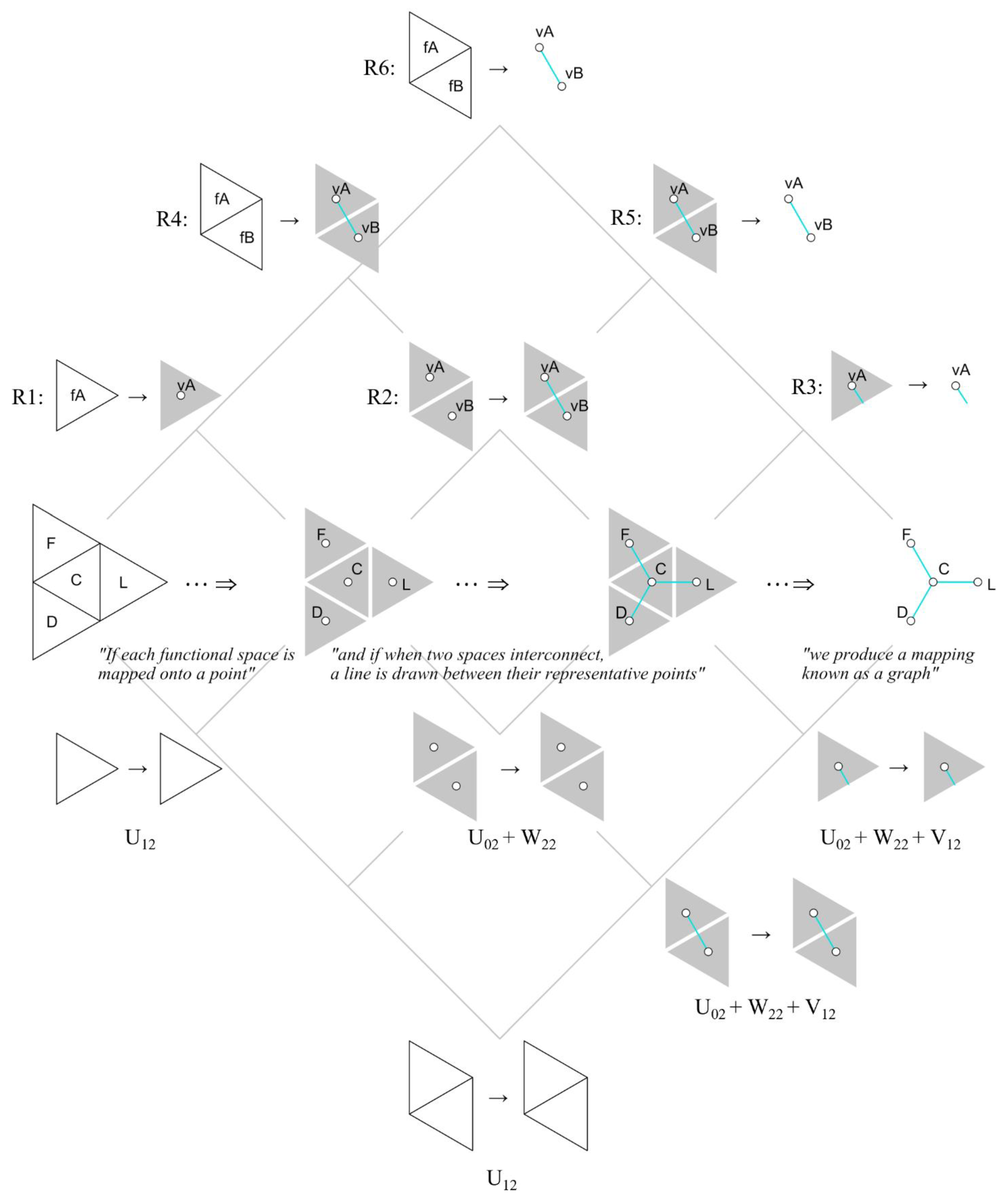

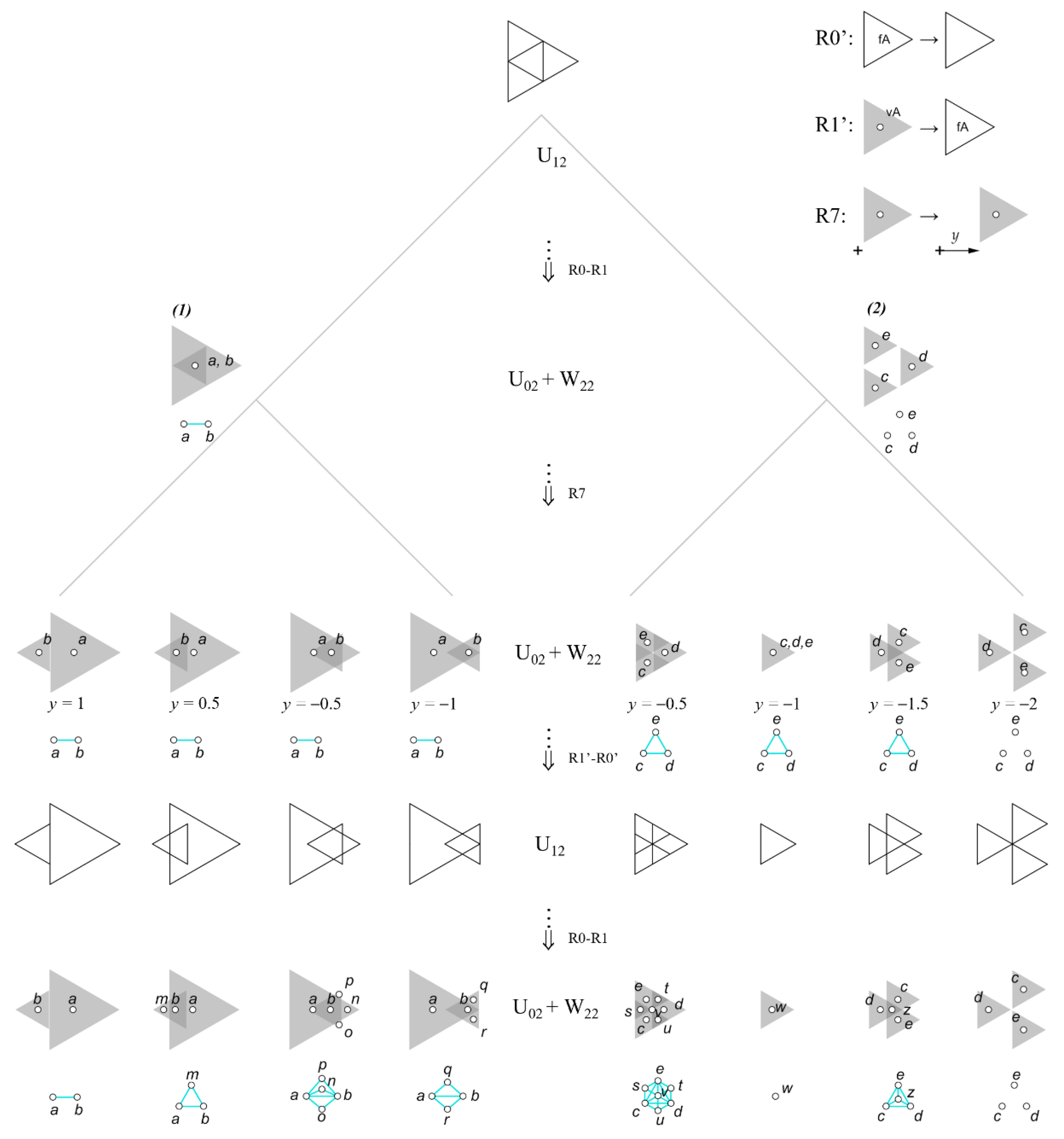
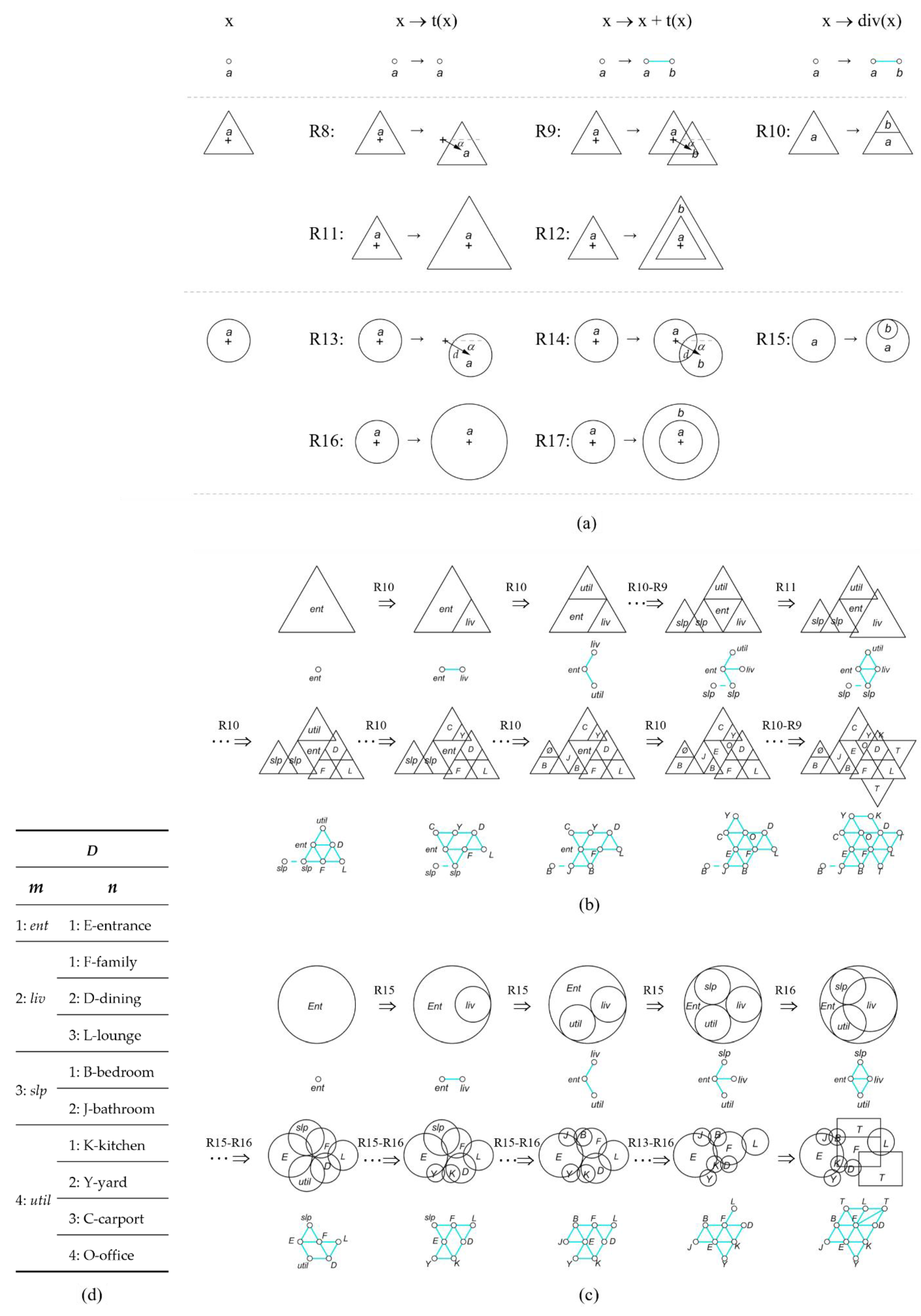
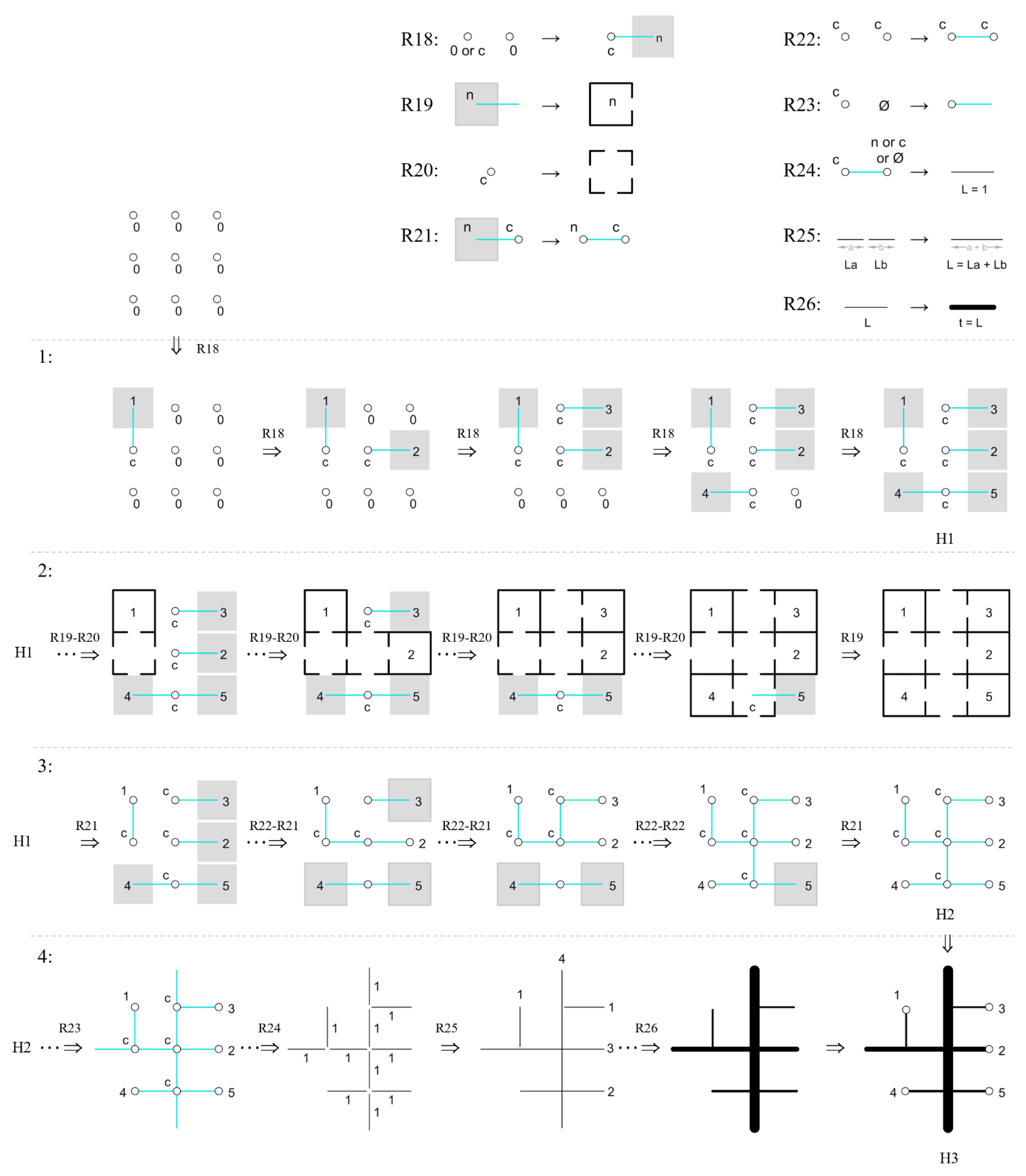
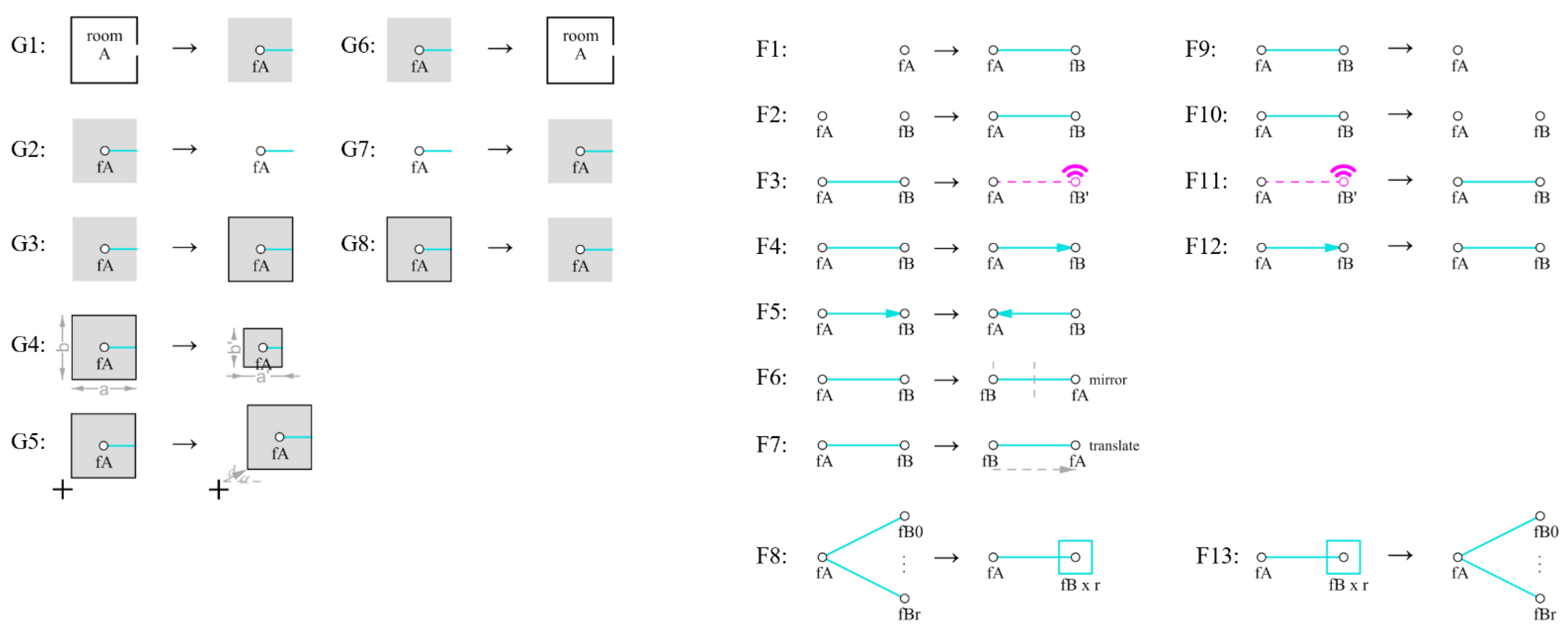


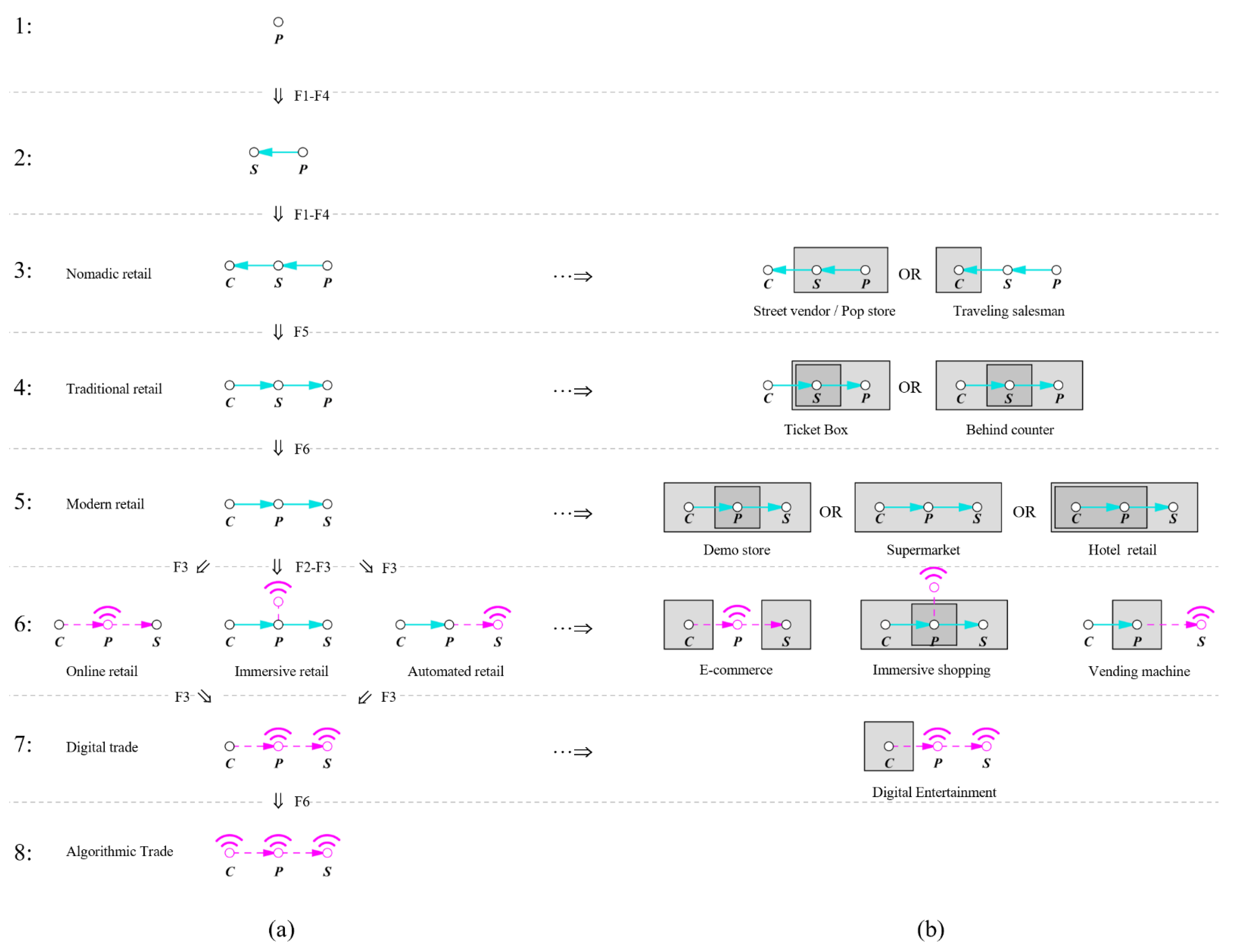
| Terminology | Definition |
|---|---|
| Shape | A set shape of i dimensions arranged in j-dimensional space within an algebra Uij, where j- refers to 0-, 1-, 2- or 3- dimensional space, and i- refers to 0 for points, 1 for lines, 2 for planes, and 3 for solids. |
| Label | A mark to define shape Uij orientation and position by using a shape in algebra Vij (e.g., points (V0j), lines (V1j), or planes (V2j)) or symbols (e.g., with a letter or number). |
| Weight | A graphical property associated with shape Uij in algebra Wij; for instance, a point (U0j) can be weighted with a plane (W2j), a line (U1j) weighted with thickness (W1j), or a plane (U2j) weighted with tones (W2j). In the figures, plane weight is shown in a grey tone and line weight with a black colour. |
| Shape rule | A mapping function (R) to transform shape A into shape B in format R: A → B. Given a shape C, a formula (C-t(A)) + t(B) applies if there is a transformation of shape A or t(A) in shape C. |
| Rule computation | A step-by-step shape rule iteration application whenever a shape matches the left-hand shape of a rule, noted by a double arrow, e.g., C0 ⇒ C1 ⇒ C2 … ⇒ Cn, where shapes C0 to Cn mark the output shapes from the previous step as the input shape for the next step. The three dots […] indicate multiple rules applied in one step (nested between steps). |
| Rule schema | An assignment function in format x → y that assigns a predicate shape as the values for variable x and y with assignment g, such that g(x) → g(y) would compose a shape rule A → B. |
| Shape description | A set of descriptions (D) to describe a context for applying shape rules (G) (e.g., a spatial, functional context), assigned with a description function h: LG → D. |
| Graph | A set of nodes (V), such as nodes {a, b, c, d}, connected by a set of edges (E), such as ((a, b), (b, c), (c, d), (d, e)), such that graph G = (V, E). In SS, nodes in the graph usually denote spaces (e.g., streets, rooms, or corridors), and the lines represent the connection or intersection between pairs of spaces. To distinguish the edge from a line in U1j, the edges are coloured cyan. |
Disclaimer/Publisher’s Note: The statements, opinions and data contained in all publications are solely those of the individual author(s) and contributor(s) and not of MDPI and/or the editor(s). MDPI and/or the editor(s) disclaim responsibility for any injury to people or property resulting from any ideas, methods, instructions or products referred to in the content. |
© 2023 by the author. Licensee MDPI, Basel, Switzerland. This article is an open access article distributed under the terms and conditions of the Creative Commons Attribution (CC BY) license (https://creativecommons.org/licenses/by/4.0/).
Share and Cite
Muslimin, R. Experience Grammar: Creative Space Planning with Generative Graph and Shape for Early Design Stage. Buildings 2023, 13, 869. https://doi.org/10.3390/buildings13040869
Muslimin R. Experience Grammar: Creative Space Planning with Generative Graph and Shape for Early Design Stage. Buildings. 2023; 13(4):869. https://doi.org/10.3390/buildings13040869
Chicago/Turabian StyleMuslimin, Rizal. 2023. "Experience Grammar: Creative Space Planning with Generative Graph and Shape for Early Design Stage" Buildings 13, no. 4: 869. https://doi.org/10.3390/buildings13040869
APA StyleMuslimin, R. (2023). Experience Grammar: Creative Space Planning with Generative Graph and Shape for Early Design Stage. Buildings, 13(4), 869. https://doi.org/10.3390/buildings13040869







